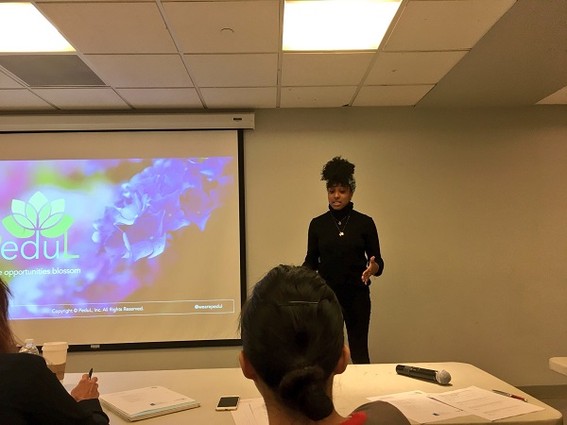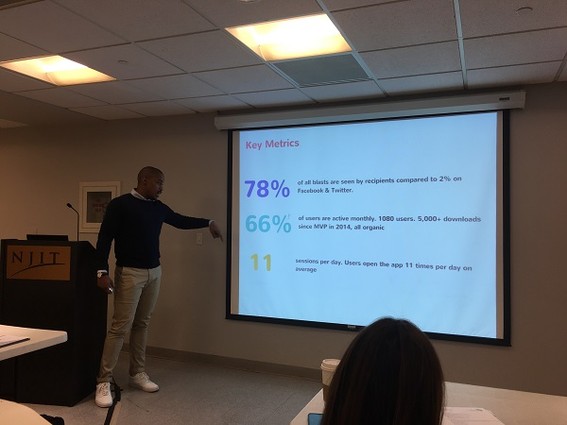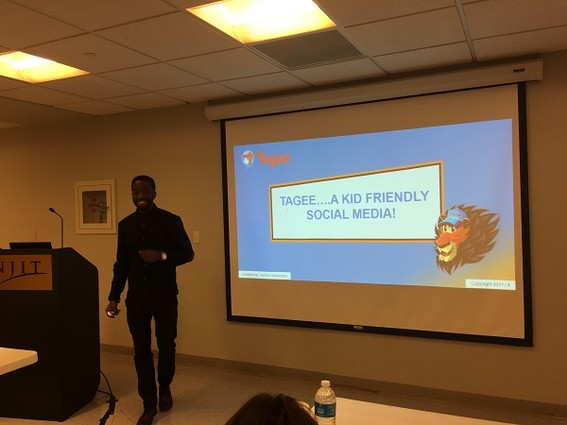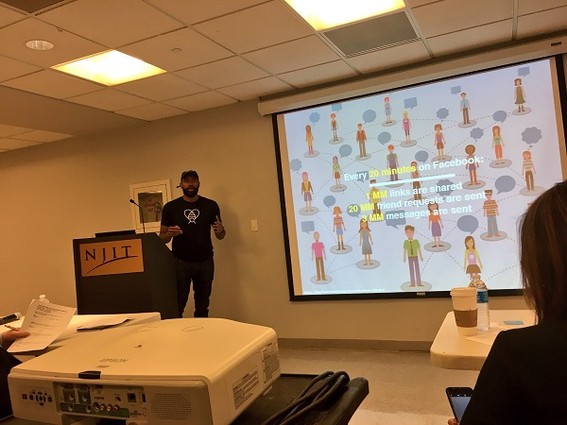Startups from Community and Area Colleges Pitch at Newark Innovation Acceleration Challenge
At the Newark Innovation Acceleration Challenge in November, community members and students competed for $3,000 and the chance to work at the NJIT School of Management’s Lean Startup Accelerator this summer.
We heard pitches from a number of students and startups. Here are some of them:

PeduL: Speaking for PeduL (Newark), Kayla Jackson said the company “operates between the difficult-to-navigate traditional process of applying for scholarships and the crippling process of applying for loans.” She added, “We think we can help the 12.5 million students in the U.S. who actively seek the financial aid they need to pursue higher education” each year.
Essentially, PeduL is a crowdfunding platform that lets students raise money for college. “We uniquely transfer funds from student campaigns to their university in the form of a third-party scholarship,” said Jackson. Students don’t just fundraise from their friends and families. PeduL optimizes their crowdfunding campaigns in partnership with influencers, scholarship providers and corporations, who can award endowments to students on the platform through a common application.
“Scholarship providers use us because it gives them access to a large applicant pool,” she said. “And corporations use us because it gives them an opportunity to cultivate a diverse workforce.” Institutions can have a page, and tax-deductible donations are distributed on that page to students who want to go to NJIT, for example. GoFundMe is PeduL’s fiercest competitor.

Blastchat: Jhamar D. Youngblood, the founder of Blastchat, described this social messaging app, which allows users to blast direct messages to friends, customers, fans and others in real time. The startup has “simplified the process of sharing real-time information.”
Youngblood talked about his background. “Three years ago, I was in graduate school at Dartmouth College, and I Googled an employer and then tweeted at them. In 24 hours, no one replied to me. I realized that this wasn’t an effective way to communicate with people.” Youngblood was also part of a young startup in China that communicated with its team using WeChat. “I realized that the future of mass communications was social messaging.”
He noted that Generation Z will comprise 40 percent of the population in 2020, and they do not subscribe to email newsletters. There are companies that rely on delivering information via email, but by 2020, 40 percent of their customers won’t be there, he said. Just as chat boxes will become the new websites, he is “convinced that social messaging will be the new paradigm” for distributing real-time information.
Blastchat is simple to use, he said. You create the message and you press “blast.” The content appears on every recipient’s device. And you can chat individually with every recipient for 24 hours. This is by far the fastest way to communicate, he noted. Blastchat has also been used in an application for the City of Newark. In this case, a user sets up a trusted group of friends and family, and can send a Blastchat message to that list if he or she feels in danger, just by pressing a button.

TAGEE: Julius Richards, founder of TAGEE (Newark) spoke for the startup, which is developing kid-friendly social media. “Too many kids want to be grown up and experience the same things that their parents and older brothers and sisters do,” Richards said. TAGEE provides a safe social media experience for kids. After all, kids are very social, and they need to develop responsible social media habits, he said.
With TAGEE, parents are given the ability to filter out anything they don’t want their children to see, said Richards. Also, TAGEE aggregates content from Twitter, Instagram and Facebook to allow children to see age-appropriate content that’s not going to “hurt their eyes or get them in trouble,” he added.
Parents choose from curated hashtags. The app includes real-time messaging and allows the children to earn prizes for the messages they send within the TAGEE app. There’s also a dashboard that aggregates all the content from all related media, including videos. It allows the kids to select a great image and connect with other kids who are also viewing these same media. Once they get permission from their parents, kids are also able to talk to one another through direct messaging.

TOMO! Frank Ozoria, cofounder of TOMO! (Teaneck), pitched a version of the app that has been enhanced by a partnership with an artificial-intelligence company.
It’s no secret that social media is a big part of our lives, he said. Essentially, what is happening is that it’s difficult for users to connect through all the platforms. Ozoria explained that TOMO! is a platform that allows users to connect instantly across multiple platforms and increase their social visibility. “If I was networking with you earlier today, I wouldn’t necessarily know where you were on social media. What TOMO! does is allow you to link everything into one central hub and show you an entire social footprint.”
Why TOMO!? Ozoria answered that people want to connect. You go to the platform, register as a TOMO! user and get a code. You then link your account to TOMO! and invite people to be friends. TOMO! built in a viral loop because a social-media platform is only successful if your friends are on it. “So, we created a hook where you can invite your friends and see their social media” platforms, Ozoria said.
TOMO! does not plan to sell ad space. “What we are looking to do is sell audiences. Users will link their social media accounts to TOMO! and that will help us produce first-party insights. All of those insights will be dumped into a data link which will be analyzed by an artificial-intelligence company, which we partnered with recently. That will help us create audience segments that we can sell to ad tech partners.”

